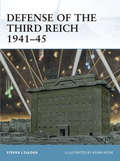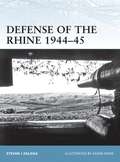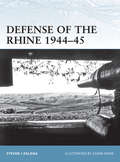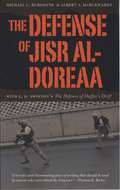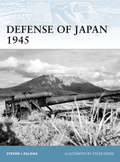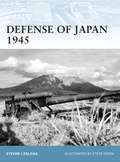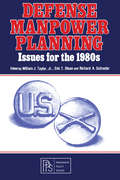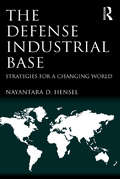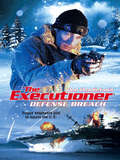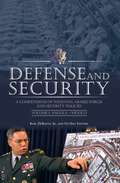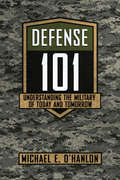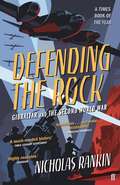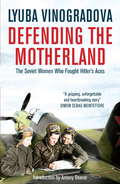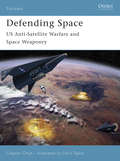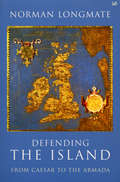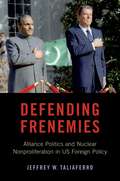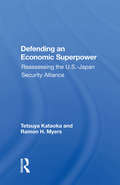- Table View
- List View
Defense of the Third Reich 1941–45 (Fortress #107)
by Steven J. Zaloga Adam HookStarting in 1940, Germany was subjected to a growing threat of Allied bomber attack. The RAF night bombing offensive built up in a slow but unrelenting crescendo through the Ruhr campaign in the summer of 1944 and culminating in the attacks on Berlin in the autumn and early winter of 1943-44. They were joined by US daylight raids which first began to have a serious impact on German industry in the autumn of 1943. This book focuses on the land-based infrastructure of Germany's defense against the air onslaught. Besides active defense against air attack, Germany also invested heavily in passive defense such as air raid shelters. While much of this defense was conventional such as underground shelters and the dual use of subways and other structures, Germany faced some unique dilemmas in protecting cities against night fire bomb raids. As a result, German architects designed massive above-ground defense shelters which were amongst the most massive defensive structures built in World War II.
Defense of the Rhine 1944–45 (Fortress)
by Steven J. Zaloga Adam HookThe Rhine River represented the last natural defensive barrier for the Third Reich in the autumn of 1944. Although Hitler had been reluctant to allow the construction of tactical defence lines in France, the final defense of the Reich was another matter. As a result, construction of a Rhine defence line began in September 1944. Steven J. Zaloga examines the multiple phases of construction undertaken to strengthen the Westwall (Siegfried Line), to fortify many of the border villages, and finally to prepare for the demolition of the Rhine bridges. Using detailed maps, colour artwork, and expert analysis, this book takes a detailed look at Germany's last line of defence.
Defense of the Rhine 1944–45 (Fortress #102)
by Steven J. Zaloga Mr Adam HookThe Rhine River represented the last natural defensive barrier for the Third Reich in the autumn of 1944. Although Hitler had been reluctant to allow the construction of tactical defence lines in France, the final defense of the Reich was another matter. As a result, construction of a Rhine defence line began in September 1944. Steven J. Zaloga examines the multiple phases of construction undertaken to strengthen the Westwall (Siegfried Line), to fortify many of the border villages, and finally to prepare for the demolition of the Rhine bridges. Using detailed maps, colour artwork, and expert analysis, this book takes a detailed look at Germany's last line of defence.
The Defense of the Napoleonic Kingdom of Northern Italy, 1813-1814
by George F. Nafziger Marco GioanniniLittle has been written about the defense of the Kingdom of Northern Italy, and this is the first study in English to detail the two-year conflict (1813-1814) within the larger context of the Napoleonic Wars. The French commander responsible for the defense was Eugene Beauharnais, stepson of Napoleon and son-in-law of the King of Bavaria. Outnumbered three to one, Beauharnais fought an outstanding defensive campaign, covering all of Napoleon's southern front while Napoleon faced off against the main allied armies as they invaded France.This was only Beauharnais's third command, and as a result of his less than stellar performance in his two earlier posts, he had acquired a poor reputation as a leader. Nafziger and Gioannini explain, however, that in this instance Beauharnais proved himself once and for all as the commander of an independent army, defending one of the most important parts of the French Napoleonic Empire. He made full use of geography, keeping his army in being, rather than risking it to seek a decision in the field. Because his stepson held the plains of Italy, Napoleon was able to concentrate his energies upon the evacuation of Germany and to demonstrate his military prowess in France.
The Defense of Jisr al-Doreaa: With E. D. Swinton's "The Defence of Duffer's Drift"
by Michael L. Burgoyne Albert J. MarckwardtFollowing the invasion of Iraq in 2003 the U.S. military found itself in a battle with a lethal and adaptive insurgency, where the divisions between enemy and ally were ambiguous at best, and working with the local population was essential for day-to-day survival. From the lessons they learned during multiple tours of duty in Iraq, two American veterans have penned The Defense of Jisr al-Doreaa, an instructional parable of counterinsurgency that addresses the myriad of difficulties associated with war in the postmodern era. In this tactical primer based on the military classic The Defence of Duffer’s Drift, a young officer deployed for the first time in Iraq receives ground-level lessons about urban combat, communications technology, and high-powered weaponry in an environment where policy meets reality. Over the course of six dreams, the inexperienced soldier fights the same battle again and again, learning each time—the hard way—which false assumptions and misconceptions he needs to discard in order to help his men avoid being killed or captured. As the protagonist struggles with his missions and grapples with the consequences of his mistakes, he develops a keen understanding of counterinsurgency fundamentals and the potential pitfalls of working with the native population. Accompanied here by the original novella that inspired it, The Defense of Jisr al-Doreaa offers an invaluable resource for cadets and junior military leaders seeking to master counterinsurgency warfare—as well as general readers seeking a deeper understanding of the wars in Iraq and Afghanistan. Just as its predecessor has been a hallmark of military instruction, The Defense of Jisr al-Doreaa will draw the road map for counterinsurgency in the postmodern world. Visit a website for the book here: www.defenseofJAD.com
The Defense of Jisr al-Doreaa: With E. D. Swinton's "The Defence of Duffer's Drift"
by Michael L. Burgoyne Albert J. MarckwardtFollowing the invasion of Iraq in 2003 the U.S. military found itself in a battle with a lethal and adaptive insurgency, where the divisions between enemy and ally were ambiguous at best, and working with the local population was essential for day-to-day survival. From the lessons they learned during multiple tours of duty in Iraq, two American veterans have penned The Defense of Jisr al-Doreaa, an instructional parable of counterinsurgency that addresses the myriad of difficulties associated with war in the postmodern era. In this tactical primer based on the military classic The Defence of Duffer’s Drift, a young officer deployed for the first time in Iraq receives ground-level lessons about urban combat, communications technology, and high-powered weaponry in an environment where policy meets reality. Over the course of six dreams, the inexperienced soldier fights the same battle again and again, learning each time—the hard way—which false assumptions and misconceptions he needs to discard in order to help his men avoid being killed or captured. As the protagonist struggles with his missions and grapples with the consequences of his mistakes, he develops a keen understanding of counterinsurgency fundamentals and the potential pitfalls of working with the native population. Accompanied here by the original novella that inspired it, The Defense of Jisr al-Doreaa offers an invaluable resource for cadets and junior military leaders seeking to master counterinsurgency warfare—as well as general readers seeking a deeper understanding of the wars in Iraq and Afghanistan. Just as its predecessor has been a hallmark of military instruction, The Defense of Jisr al-Doreaa will draw the road map for counterinsurgency in the postmodern world. Visit a website for the book here: www.defenseofJAD.com
The Defense of Jisr al-Doreaa: With E. D. Swinton's "The Defence of Duffer's Drift"
by Michael L. Burgoyne Albert J. MarckwardtFollowing the invasion of Iraq in 2003 the U.S. military found itself in a battle with a lethal and adaptive insurgency, where the divisions between enemy and ally were ambiguous at best, and working with the local population was essential for day-to-day survival. From the lessons they learned during multiple tours of duty in Iraq, two American veterans have penned The Defense of Jisr al-Doreaa, an instructional parable of counterinsurgency that addresses the myriad of difficulties associated with war in the postmodern era. In this tactical primer based on the military classic The Defence of Duffer’s Drift, a young officer deployed for the first time in Iraq receives ground-level lessons about urban combat, communications technology, and high-powered weaponry in an environment where policy meets reality. Over the course of six dreams, the inexperienced soldier fights the same battle again and again, learning each time—the hard way—which false assumptions and misconceptions he needs to discard in order to help his men avoid being killed or captured. As the protagonist struggles with his missions and grapples with the consequences of his mistakes, he develops a keen understanding of counterinsurgency fundamentals and the potential pitfalls of working with the native population. Accompanied here by the original novella that inspired it, The Defense of Jisr al-Doreaa offers an invaluable resource for cadets and junior military leaders seeking to master counterinsurgency warfare—as well as general readers seeking a deeper understanding of the wars in Iraq and Afghanistan. Just as its predecessor has been a hallmark of military instruction, The Defense of Jisr al-Doreaa will draw the road map for counterinsurgency in the postmodern world. Visit a website for the book here: www.defenseofJAD.com
Defense of Japan 1945 (Fortress #99)
by Steven J. Zaloga Mr Steve NoonIn 1945, with her fleet destroyed and her armies beaten, the only thing that stood between Japan and an Allied invasion was the numerous coastal defence positions that surrounded the islands. This is the first book to take a detailed look at the Japanese home island fortifications that were constructed during 1941–45. Utilizing diagrams, specially commissioned artwork, and sources previously unavailable in English, Steven Zaloga examines these defences in the context of a possible Allied invasion, constructing various arguments for one of the greatest 'what if' scenarios of World War II, and helping to explain why the Americans decided to go ahead with a nuclear option.
Defense of Japan 1945 (Fortress #99)
by Steven J. Zaloga Steve NoonIn 1945, with her fleet destroyed and her armies beaten, the only thing that stood between Japan and an Allied invasion was the numerous coastal defence positions that surrounded the islands. This is the first book to take a detailed look at the Japanese home island fortifications that were constructed during 1941–45. Utilizing diagrams, specially commissioned artwork, and sources previously unavailable in English, Steven Zaloga examines these defences in the context of a possible Allied invasion, constructing various arguments for one of the greatest 'what if' scenarios of World War II, and helping to explain why the Americans decided to go ahead with a nuclear option.
Defense Manpower Planning: Issues for the 1980s
by William J. Taylor Eric T. Olson Richard A. SchraderDefense Manpower Planning discusses the important set of national security issues related to defense manpower for the 1980s. The topics in the text focus on the problems of manpower acquisition and retention. The historical background and description of the military power during the 1970s and 1980s are given in detail. A military manpower chronology is provided. The book enumerates some of the manpower issues and debates. Such salient issues as the quantity, quality, socio-economic factors, and the issue of cost, combat effectiveness, and readiness factors are carefully considered. After listing the issues, solutions are then presented. The variants of the all-volunteer force, of conscription, and combining volunteers and conscripts are suggested. A part of the book focuses on active duty forces. The issue of employing women in the military is fully addressed. A description of combat is also tackled. A section of the text explains the relationship between precision guided munitions and the volunteer force. The book will provide useful information to defense military planners, historians, and students of history.
The Defense Industrial Base: Strategies for a Changing World
by Nayantara HenselThe US and international defense industrial sectors have faced many challenges over the last twenty years, including cycles of growth and shrinkage in defense budgets, shifts in strategic defense priorities, and macroeconomic volatility. In the current environment, the defense sector faces a combination of these challenges and must struggle with the need to maintain critical aspects of the defense industrial base as defense priorities change and as defense budgets reduce or plateau. Moreover, the defense sector in the US is interconnected both with defense sectors in other countries and with other industry sectors in the US and global economies. As a result, strategic decisions made in one defense sector impact the defense sectors of other countries, as well as other areas of the economy. Given her academic, corporate, and Department of Defense experience as a leading economist and policy-maker, Dr. Nayantara Hensel is perfectly positioned to examine the interrelationship between these forces both historically and in the current environment, and to assess the implications for the future global defense industrial base.
The Defense Industrial Base: Strategies for a Changing World
by Nayantara HenselThe US and international defense industrial sectors have faced many challenges over the last twenty years, including cycles of growth and shrinkage in defense budgets, shifts in strategic defense priorities, and macroeconomic volatility. In the current environment, the defense sector faces a combination of these challenges and must struggle with the need to maintain critical aspects of the defense industrial base as defense priorities change and as defense budgets reduce or plateau. Moreover, the defense sector in the US is interconnected both with defense sectors in other countries and with other industry sectors in the US and global economies. As a result, strategic decisions made in one defense sector impact the defense sectors of other countries, as well as other areas of the economy. Given her academic, corporate, and Department of Defense experience as a leading economist and policy-maker, Dr. Nayantara Hensel is perfectly positioned to examine the interrelationship between these forces both historically and in the current environment, and to assess the implications for the future global defense industrial base.
Defense and Security [2 volumes]: A Compendium of National Armed Forces and Security Policies [2 volumes]
by Karl DeRouen Uk HeoAn authoritative, up-to-date examination of the national security and defense policies of 50 influential nations and regions across the globe.Defense and Security: A Compendium of National Armed Forces and Security Policies presents highly readable, authoritative essays profiling the defense and security policies of over 50 individual countries and regions, with a focus on present-day developments.Written by leading national and international scholars and edited by eminent political science experts Karl DeRouen and Uk Heo, the essays take an in-depth look at each nation's current security situation, defense spending, present and potential military confrontations, civil–military relations, alliances, relations to terrorism, and other topics of importance. Historical events and conflicts are highlighted as well, with emphasis on the post–Cold War era. The essays are parallel in structure, allowing readers to pinpoint similarities and draw comparisons among nations. The two-volume set also includes a detailed introduction featuring a cross-national comparison.
Defense 101: Understanding the Military of Today and Tomorrow
by Michael E. O'HanlonIn Defense 101, a concise primer for understanding the United States' $700+ billion defense budget and rapidly changing military technologies, Michael O'Hanlon provides a deeply informed yet accessible analysis of American military power.After an introduction in which O'Hanlon surveys today's international security environment, provides a brief sketch of the history of the US military, its command structure, the organization of its three million personnel, and a review of its domestic basing and global reach, Defense 101 provides in-depth coverage of four critical areas in military affairs: • Defense Budgeting and Resource Allocation: detailed budget and cost breakdowns, wartime spending allocations, economics of overseas basing, military readiness, and defense budgeting versus US grand strategy• Gaming and Modeling Combat: wargaming, micro modeling, nuclear exchange calculations, China scenarios, and assessments of counterinsurgency missions• Technological Change and Military Innovation: use of computers, communications, and robotics, cutting-edge developments in projectiles and propulsion systems• The Science of War, military uses of space, missile defense, and nuclear weapons, testing, and proliferationFor policy makers and experts, military professionals, students, and citizens alike, Defense 101 helps make sense of the US Department of Defense, the basics of war and the future of armed conflict, and the most important characteristics of the American military.
Defending the Rock: How Gibraltar Defeated Hitler
by Nicholas RankinAdolf Hitler's failure to take Gibraltar in 1940 lost him the Second World War. But in truth the formidable Rock, jutting between the Mediterranean and the Atlantic, was extraordinarily vulnerable. Every day, ten thousand people crossed its frontier to work, spy, sabotage or escape. It was threatened by Spain, Vichy France, Italy and Germany. After the USA entered the war, Gibraltar became General Eisenhower's strategic headquarters for the invasion of North Africa and the battle for the Mediterranean.
Defending the realm?: The politics of Britain’s small wars since 1945
by Aaron EdwardsBritain is often revered for its extensive experience of waging ‘small wars’. Its long imperial history is littered with high profile counter-insurgency campaigns, thus marking it out as the world’s most seasoned practitioner of this type of warfare. This is the first book to detail the tactical and operational dynamics of Britain’s small wars, arguing that the military’s use of force was more heavily constrained by wider strategic and political considerations than previously admitted. Outlining the civil-military strategy followed by the British in Palestine, Malaya, Kenya, Cyprus, Aden, Northern Ireland, Iraq and Afghanistan, Defending the realm? argues that Britain’s small wars since 1945 were fought against the backdrop of an irrevocable decline in British power. Written from a theoretically-informed perspective, grounded in rich archival sources, oral testimonies and a revisionist reading of the literature on counter-insurgency and counter-terrorism, this is the definitive account of the politics of Britain’s small wars.
Defending the Motherland: The Soviet Women Who Fought Hitler's Aces
by Lyuba VinogradovaPlucked from every background, and led by an N.K.V.D. Major, the new recruits who boarded a train in Moscow on 16th October 1941 to go to war had much in common with millions of others across the world. What made the 586th Fighter Regiment, the 587th Heavy-bomber Regiment and the 588th Regiment of light night-bombers unique was their gender: the Soviet Union was creating the first all-female active combat units in modern history.Drawing on original interviews with surviving airwomen, Lyuba Vinogradova weaves together the untold stories of the female Soviet fighter pilots of the Second World War. From that first train journey to the last tragic disappearance, Vinogradova's panoramic account of these women's lives follows them from society balls to unmarked graves, from landmark victories to the horrors of Stalingrad. Battling not just fearsome Aces of the Luftwaffe but also patronising prejudice from their own leaders, women such as Lilya Litvyak and Ekaterina Budanova are brought to life by the diaries and recollections of those who knew them, and who watched them live, love, fight and die.
Defending Space: US Anti-Satellite Warfare and Space Weaponry (Fortress)
by Clayton Chun Chris TaylorThe United States has been developing space for many years, and satellites provide the US Military with an unparaleled advantage over its adversaries. Constellations of both military and civilian satellites provide protection and support for military operations; deliver ballistic missile early warning; supply reliable, secure and jam-proof communications; gather audio-visual intelligence; predict weather patterns; guide navigation; and deliver guided-weapons targeting, as well as a host of other missions. This book explores the design, development and usage of US military space systems, as well past and future threats to the systems. The current relevance of this topic to the international community as a whole is key, as space becomes the next, if only virtual, theater of warfare.
Defending Space: US Anti-Satellite Warfare and Space Weaponry (Fortress #53)
by Clayton Chun Chris TaylorThe United States has been developing space for many years, and satellites provide the US Military with an unparaleled advantage over its adversaries. Constellations of both military and civilian satellites provide protection and support for military operations; deliver ballistic missile early warning; supply reliable, secure and jam-proof communications; gather audio-visual intelligence; predict weather patterns; guide navigation; and deliver guided-weapons targeting, as well as a host of other missions. This book explores the design, development and usage of US military space systems, as well past and future threats to the systems. The current relevance of this topic to the international community as a whole is key, as space becomes the next, if only virtual, theater of warfare.
Defending The Island: From Caesar to the Armada
by Norman LongmateIn a brilliantly imaginative blend of military, social and diplomatic history, Norman Longmate retells our island story from the perspective of its defenders, in a narrative which stretches from the Celtic tribes who unsuccessfully fought against Ceasar to the great seabourne defence against the Armada of Philip of Spain. He has gone back to the original sources and investigated the original battlegrounds and weak spots in Britain's defences. But the real strength of his book is its seamless narrative of history, which uncovers the truth behind the legends. A mass of solidly researched fact, not readily found elsewhere, is seasoned with lively, humorous and occassionally gruesome anecdote. The result, providing at once an invaluable sourcebook for the specialist and an enthralling narrative for the general reader, is by far the most comprehensive and accessible history of England versus invasion ever published.
Defending Frenemies: Alliances, Politics, and Nuclear Nonproliferation in US Foreign Policy
by Jeffrey W. TaliaferroThe United States maintains defense ties with as many as 60 countries, which not only enables its armed forces to maintain command globally and to project its force widely, but also enables its government to exert leverage over allies' foreign policies and military strategies. In Defending Frenemies, Jeffrey W. Taliaferro presents a historical and comparative analysis of how successive US presidential administrations have employed inducements and coercive diplomacy toward Israel, Pakistan, South Korea, and Taiwan over nuclear proliferation. Taliaferro shows that the ultimate goals in each administration, from John F. Kennedy to George H. W. Bush, have been to contain the Soviet Union's influence in the Middle East and South Asia and to enlist China as an ally of convenience against the Soviets in East Asia. Policymakers' inclinations to pursue either accommodative strategies or coercive nonproliferation strategies toward allies have therefore been directly linked to these primary objectives. Defending Frenemies is sharp examination of how regional power dynamics and US domestic politics have shaped the nonproliferation strategies the US has pursued toward vulnerable and often obstreperous allies.
Defending Frenemies: Alliances, Politics, and Nuclear Nonproliferation in US Foreign Policy
by Jeffrey W. TaliaferroThe United States maintains defense ties with as many as 60 countries, which not only enables its armed forces to maintain command globally and to project its force widely, but also enables its government to exert leverage over allies' foreign policies and military strategies. In Defending Frenemies, Jeffrey W. Taliaferro presents a historical and comparative analysis of how successive US presidential administrations have employed inducements and coercive diplomacy toward Israel, Pakistan, South Korea, and Taiwan over nuclear proliferation. Taliaferro shows that the ultimate goals in each administration, from John F. Kennedy to George H. W. Bush, have been to contain the Soviet Union's influence in the Middle East and South Asia and to enlist China as an ally of convenience against the Soviets in East Asia. Policymakers' inclinations to pursue either accommodative strategies or coercive nonproliferation strategies toward allies have therefore been directly linked to these primary objectives. Defending Frenemies is sharp examination of how regional power dynamics and US domestic politics have shaped the nonproliferation strategies the US has pursued toward vulnerable and often obstreperous allies.
Defending An Economic Superpower: Reassessing The U.s.-japan Security Alliance
by Tetsuya KataokaThis book describes the reassessment of the U.S.-Japan security relationship to determine how Japan can do more for its defense, reduce America's spending for Japan's and Asia's security, yet preserve the peace in that region. It raises six questions about the relationship and tries to answer them.
Defending An Economic Superpower: Reassessing The U.s.-japan Security Alliance
by Tetsuya KataokaThis book describes the reassessment of the U.S.-Japan security relationship to determine how Japan can do more for its defense, reduce America's spending for Japan's and Asia's security, yet preserve the peace in that region. It raises six questions about the relationship and tries to answer them.
